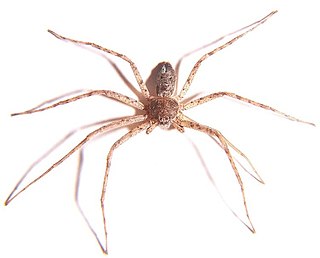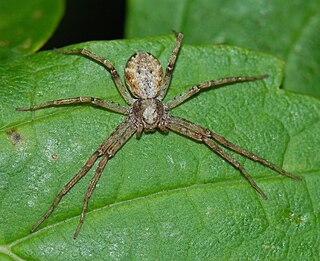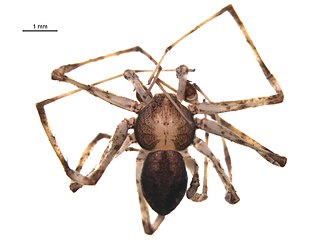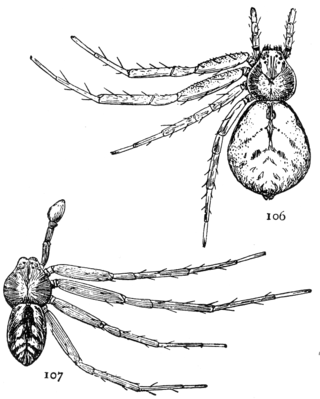
Philodromidae, also known as philodromid crab spiders and running crab spiders, is a family of araneomorph spiders first described by Tord Tamerlan Teodor Thorell in 1870. It contains over 500 species in thirty genera.

Philodromus is a genus of philodromid crab spiders. Spiders in this genus are distinctively flattened.

Geoffroy's bat, also known as the notch-eared bat, is a species of vesper bat.
Philodromus vulgaris is a species of spider, commonly called the longlegged crab spider, in the genus Philodromus found in the USA and Canada.

Philodromus aureolus, the wandering crab spider, is a mainly European running crab spider of the family Philodromidae. The taxonomy of the species group named after Philodromus aureolus is in a state of flux and a number of new species have recently been recognised.
Philodromus anomalus is a spider in the family Philodromidae, in the infraorder Araneomorphae . It is found in the USA.
Philodromus spectabilis is a species of running crab spider in the family Philodromidae. It is found in the USA and Canada.

Philodromus cespitum is a species of running crab spider in the family Philodromidae. It is found in North America, Europe, North Africa, and parts of the Middle East and Asia. P. cespitum is a foliage-dweller, and is the most abundant species found in European fruit orchards. It acts as a biological control by preying on orchard pests. P. cespitum is a diurnal ambush hunter and preys on aphids, insects, and occasionally competitor spider species. Males court females by tapping on the females’ bodies with their forelegs. They then insert a genital plug into the female during copulation. Unlike in many other spider species, subsequent males can mate with plugged females by removing part of the plug prior to copulation. Males discriminate among females based on virginity and plug size, and can determine these factors using the females’ draglines and plug samples.
Philodromus minutus is a species of running crab spider in the family Philodromidae. It is found in the United States and Canada.
Philodromus oneida is a species of running crab spider in the family Philodromidae. It is found in the United States and Canada.
Philodromus quercicola is a species of running crab spider in the family Philodromidae. It is found in the United States.
Philodromus speciosus is a species of running crab spider in the family Philodromidae. It is found in the United States and Canada.
Philodromus josemitensis is a species of running crab spider in the family Philodromidae. It is found in the United States and Canada.

Philodromus marxi, the metallic crab spider, is a species of running crab spider in the family Philodromidae. It is found in the United States. They are a sexually dimorphic species. The males are smooth with a metallic sheen and the females present as bristly white and grey.
Philodromus peninsulanus is a species of running crab spider in the family Philodromidae. It is found in the United States and Canada.

Philodromus keyserlingi is a species of running crab spider in the family Philodromidae. It is found in the United States and Canada.

Philodromus imbecillus is a species of running crab spider in the family Philodromidae. It is found in the United States and Canada.

Philodromus rufus, also known as the White-striped Running Crab Spider is a species of running crab spider in the family Philodromidae. It is found in North America, Europe, Turkey, Caucasus, Russia (Siberia), Central Asia, China, Korea, and Japan.








